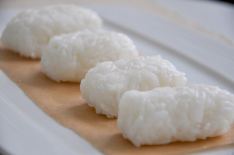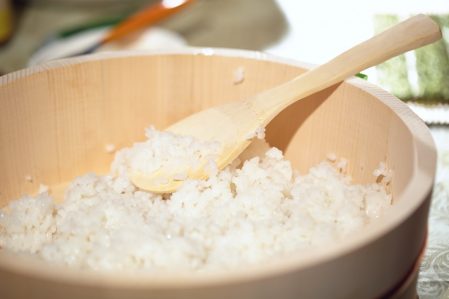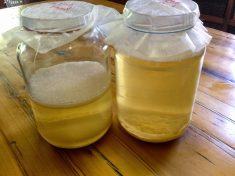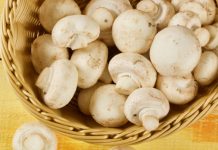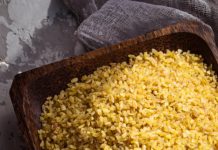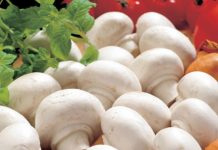Rice vinegar is a popular oriental dressing for many different dishes. Why is it better than regular vinegar? What and how to cook with it? Can I do it with my own hands? Find out the answers to these questions below.
Material Content:
Rice vinegar: what dishes are used
Typically, rice vinegar is used in Asian cuisine for seasoning rice, pickling ginger and making funchoise rice noodles. In addition, dressing acts as a component of vegetable salads, appetizers, is used in marinating chicken and in the creation of various sauces.

For example, consider a full-fledged meat dish with the addition of rice vinegar.
To create it you will need:
- potatoes - 3 tubers;
- pork fillet - 200 g;
- rice vinegar - 1 tbsp. l .;
- yellow pepper - 1 pc.;
- some oil or fat to grease the pan;
- sugar - 1 tbsp. l with a slide;
- classic soy sauce - 2 tbsp. l
Operating procedure:
- Cut the potatoes into strips as thin as possible, fry to a pale golden color with the addition of oil and transfer to another dish.
- Cut the meat and pepper into strips. First fry only meat on all sides, then add pepper and sugar to it. Then pour soy sauce and vinegar. Simmer for a couple of minutes under a closed lid.
- Turn off the heat, add previously fried potatoes, mix and arrange on plates.
On a note. Use chicken for cooking a diet or pork for a more satisfying meal.
How can I replace rice vinegar for sushi and rolls?
How can rice vinegar be replaced if it wasn’t at hand at the right time? Rice vinegar is used as a classic dressing for sushi, but this product is not always available for purchase.
In this case, you can get out of the situation by slightly improving the existing refueling using simple components:
- 5 tbsp. l vinegar 6 - 9%;
- 1 tsp salt with a hill;
- 4 tsp brown sugar.
Refueling is preparing amazingly fast:
- Heat vinegar slightly in the microwave (10 - 20 seconds, so as not to have time to boil).
- Add salt and sugar to it. Stir so that the loose components dissolve. Done!
How to add rice vinegar to sushi and rolls
Delicious tender rolls are impossible without proper cooked rice.
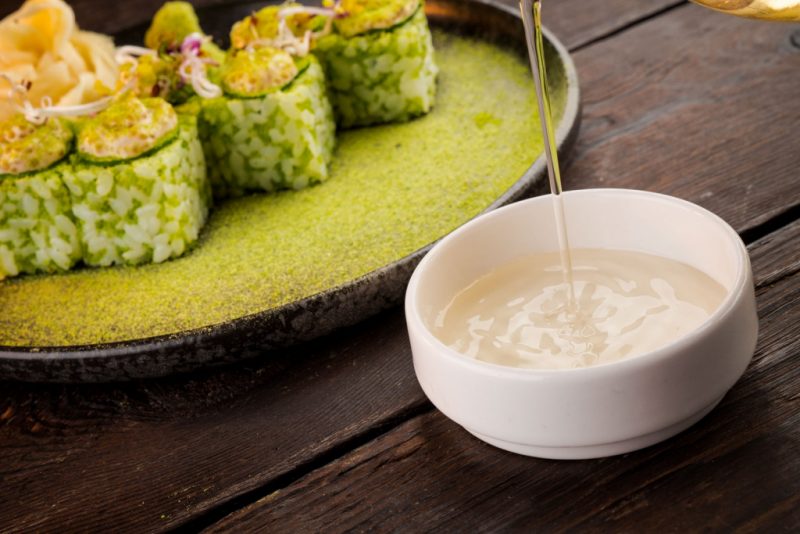
For 400 g of grain you will need:
- sugar - 40 g;
- water - 500 ml;
- rice vinegar - 60 ml;
- small salt - 10 g.
Follow the simple instructions:
- Cook rice for 10 minutes. The time should be counted, starting from the moment when the water boils.
- Remove from the stove and hold the grits under the lid for another 15 minutes. Cook the fill.
- Mix vinegar, sugar, salt. After the set time, pour this mixture into rice and mix well to distribute the dressing.
- Wait until it is absorbed, after which the rice will be ready for further use.
How to substitute for marinating meat, fish and ginger
Exotic gas station is easy to find on the shelves of a large supermarket, but usually you can’t buy it in small house stores. Then a more familiar product will help out.
If you need to prepare 1 kg of meat, then the composition of the marinade for it will be like this:
- 150 ml apple cider vinegar;
- 3 medium or 5 small onions;
- 0.5 l of water (boiled and cooled);
- 80 ml of unrefined oil.
Pickling is carried out as follows:
- We cut onions in thick half rings. Pour vinegar and oil into the water, pour the onion there.
- Pre-thawed and cut into portioned meat, immerse the meat in the marinade so that it is completely covered. If the composition is not enough, then add a little more water.
- We close the container with the meat lid and keep it in the cold for at least 6 hours.
Note: ginger can also be pickled in apple cider vinegar, and balsamic is good for meat.
How to make at home
If you want to experiment and prepare an exotic dressing yourself, then be patient, the whole process is not fast.
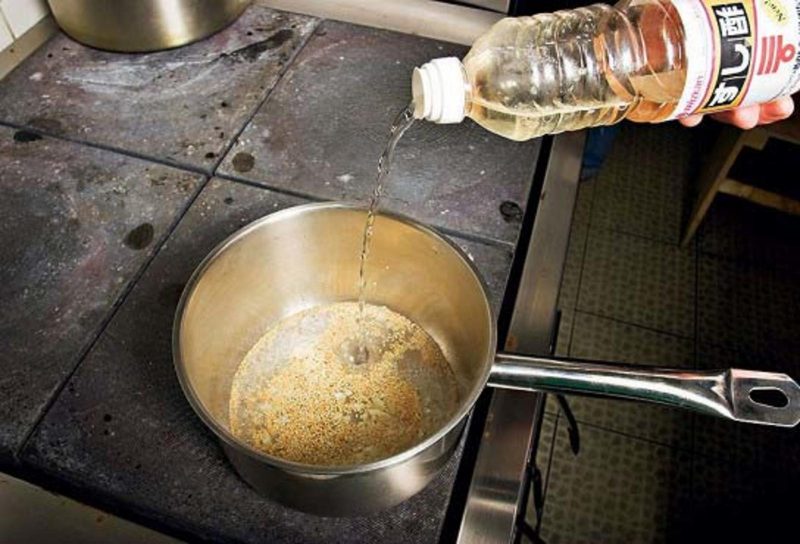
Before making rice vinegar at home, prepare these products:
- 1 cup raw white rice;
- 4 glasses of boiled water;
- 1 cup of sugar;
- 5 g of yeast;
- 1 raw egg.
How to cook rice vinegar:
- Pour rice with warm water, cover the container with a lid and keep it in a cool place for 6 hours.
- Pour the water in which the grain was infused into a separate pan. At this stage, be careful: you do not need rice, namely water, do not pour it out of habit through a colander.
- Pour sugar into the obtained rice water and heat it for 15 minutes without boiling.
- Add the yeast, pour the liquid into the jar and close the lid. Now the composition will be infused for several days, during which you can observe the formation of foam bubbles.
- In a week, the drilling will stop. Then the liquid through gauze should be poured into another jar and left for a month under a closed lid.
- After a month, the contents of the jar will need to be poured into a pan and add egg white to it. Boil the mixture, cool, strain again and pour the finished vinegar into a tightly closed bottle.
What is the difference between rice vinegar and ordinary
Common is called table vinegar, which is an aqueous solution of synthetic acetic acid. Rice vinegar is natural, it is made by fermenting rice. It differs from the dining room in a sweetish taste, softer and less acidic, which is why it is so well suited for pickling ginger.
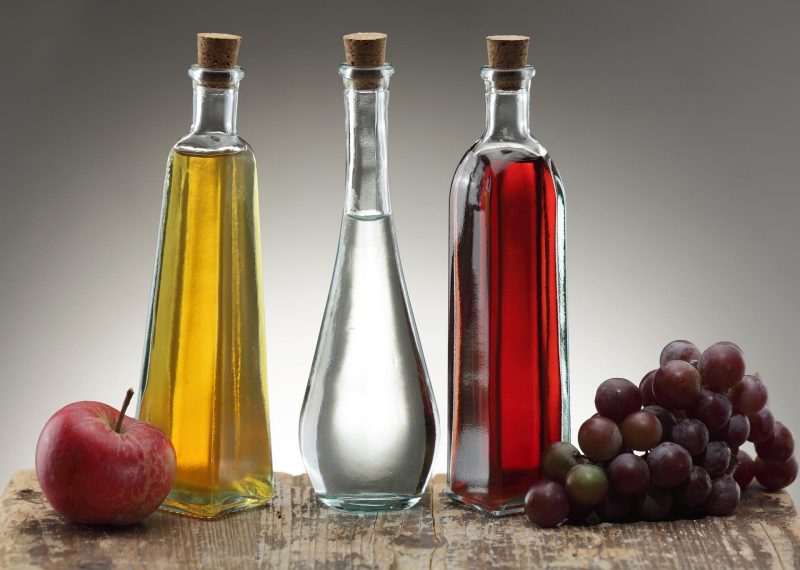
So to prepare the pickled root you need:
- water - 500 + 100 ml;
- small salt - 10 g;
- white sugar - 40 g;
- rice vinegar - 300 ml,
- ginger root - 2 pcs.
What do we do:
- Peel ginger and cut into thin (1 mm) plates. Most of the water is boiled with salt and mixed well until it is completely dissolved. Pour the ginger into the broth and hold it for 3 - 5 minutes under the lid.
- Now prepare the marinade. In half a glass of warm water, dissolve the sugar and pour the vinegar.
- We pour out the water in which the ginger was soaked. It is no longer needed, since it helped to remove a certain amount of bitterness and thoroughly soften the fiber of the product before pickling.
- Pour ginger with marinade, close the lid and stand for 8 hours.
Thus we get a delicious home-made pickled ginger. To make such an appetizer with ordinary table vinegar will fail, as well as many other dishes, the taste of which cannot be imagined without the already popular oriental dressing.



